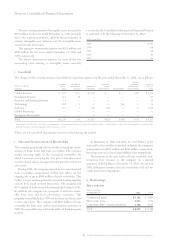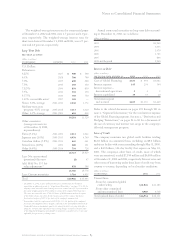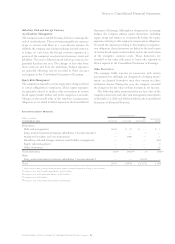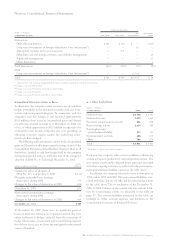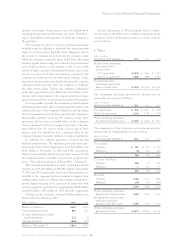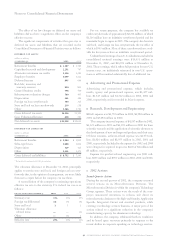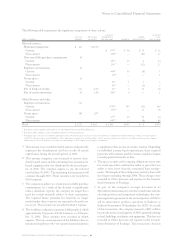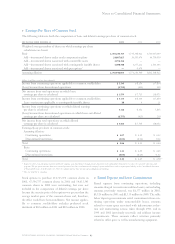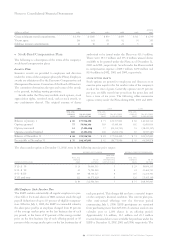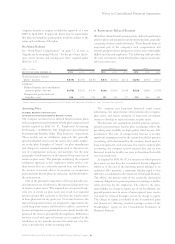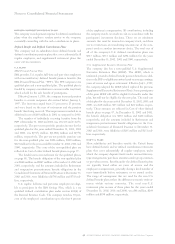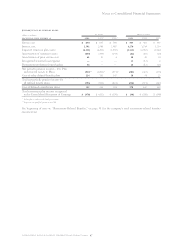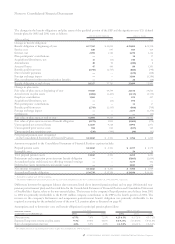IBM 2002 Annual Report Download - page 90
Download and view the complete annual report
Please find page 90 of the 2002 IBM annual report below. You can navigate through the pages in the report by either clicking on the pages listed below, or by using the keyword search tool below to find specific information within the annual report.
Notes to Consolidated Financial Statements
88 international business machines corporation and Subsidiary Companies
In addition, the company is a defendant in a class action
challenge to its defined benefit plan. The suit alleges that the
current pension plan formulas violate a number of Employee
Retirement Income Security Act (ERISA) provisions including
the ERISA age discrimination provision.
While it is not possible to predict the ultimate outcome of
the matters discussed above, given the unique factors and
circumstances involved in each matter, historically, the com-
pany has been successful in defending itself against claims and
suits that have been brought against it, and payments made by
the company in such claims and suits have not been material
to the company. The company will continue to defend itself
vigorously in all such matters and believes that if it were to
incur a loss in any such matter, such loss should not have a
material effect on the company’s business, financial condition
or results of operations.
Commitments
The company has applied the disclosure provisions of FASB
Interpretation No. 45 (FIN 45), “Guarantor’s Accounting and
Disclosure Requirements for Guarantees, Including Indirect
Guarantees of Indebtedness of Others,” to its agreements that
contain guarantee or indemnification clauses. These disclosure
provisions expand those required by FASB Statement No. 5,
“Accounting for Contingencies,” by requiring a guarantor to
net change in unrealized (losses)/gains on
marketable securities (net of tax)
(dollars in millions)
at december 31: 2002 2001
Net unrealized losses arising
during the period $«(13) $«(154)
Less: Net gains/(losses) included
in net income for the period 3*(246) *
Net change in unrealized (losses)/
gains on marketable securities $«(16) $««««92
*Includes write-downs of $36 million and $287 million in 2002 and 2001, respectively.
oContingencies and Commitments
Contingencies
The company is subject to a variety of claims and suits that
arise from time to time in the ordinary course of its business,
including actions with respect to contracts, IP, product liabil-
ity, employment and environmental matters. The company is a
defendant and/or third-party defendant in a number of cases in
which claims have been led by current and former employees,
independent contractors, estate representatives, offspring and
relatives of employees seeking damages for wrongful death and
personal injuries allegedly caused by exposure to chemicals in
various of the company’s facilities from 1964 to the present.
Employee Benefits Trust
In 1997, the company created an employee benefits trust to
which the company contributed 10 million shares of treasury
stock. The company was authorized to instruct the trustee to
sell such shares from time to time and to use the proceeds
from such sales, and any dividends paid or earnings received
on such stock, toward the partial payment of the company’s
obligations under certain of its compensation and benefit
plans. The shares held in trust were not considered outstand-
ing for earnings per share purposes until they were
committed to be released. The company did not commit any
shares for release from the trust during its existence nor were
any shares sold from the trust. The trust would have expired
accumulated gains and (losses)not affecting retained earnings*
net net accumulated
unrealized foreign minimum unrealized gains/(losses)
gains/(losses)currency pension gains/(losses)not affecting
on cash flow translation liability on marketable retained
(dollars in millions) hedge derivatives adjustments adjustment** securities earnings
December 31, 2000 $««««— $««(73) $««««(218) $«(78) $««««(369)
Cumulative effect on January 1, 2001 219 — — — 219
Change for period 77 (539) (308) 92 (678)
December 31, 2001 296 (612) (526) 14 (828)
Change for period (659) 850 (2,765) (16) (2,590)
december 31, 2002 $«(363) $«238 $«(3,291) $«««(2) $«(3,418)
*Net of tax.
** Reclassified to conform with 2002 presentation.
in 2007. Due to the fact that the company had not used the
trust, nor was it expected to need the trust prior to its expira-
tion, the company dissolved the trust, effective May 31, 2001,
and all of the shares (20 million on a split-adjusted basis) were
returned to the company as treasury shares. Dissolution of
the trust did not affect the company’s obligations related to
any of its compensation and employee benefit plans or its
ability to settle the obligations. In addition, the dissolution is
not expected to have any impact on net income. At this time,
the company plans to fully meet its obligations for the com-
pensation and benefit plans in the same manner as it does
today, using cash from operations.






